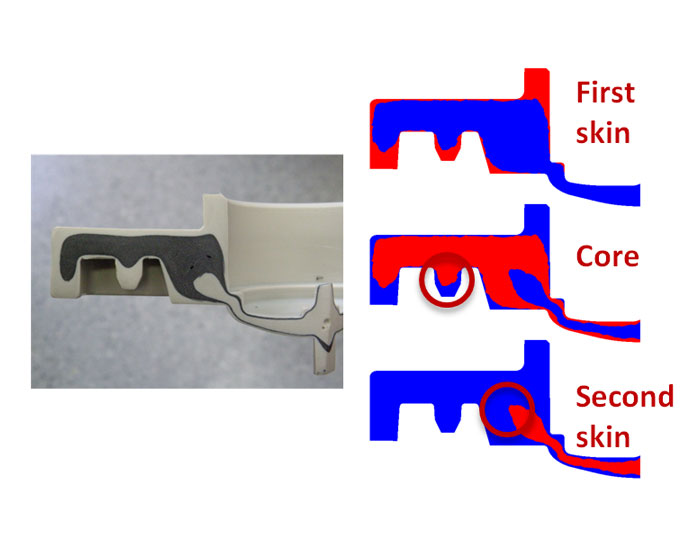What Is Co-Injection Molding?
Co-injection molding is an advanced manufacturing process that involves injecting two different polymers into a mold simultaneously. This technique allows combining distinct materials, often with differing properties, to produce parts with unique characteristics. For example, a product could feature a rigid inner core for durability and a gentle exterior layer for coziness. Businesses in different sectors utilize co-injection molding to produce more robust, longer-lasting, affordable, and efficient items. The co-injection process opens up new possibilities for manufacturers, allowing them to innovate and improve their product offerings.
Advantages of Co-Injection Molding
There are numerous benefits to using co-injection molding. One of the primary advantages is enhanced product strength. By combining two or more materials, manufacturers can produce much stronger and more durable items than those made from a single material. For example, using a rigid core with a flexible exterior can create a product that is both strong and comfortable to use. This combination of materials creates synergy that enhances the final product’s overall performance. Another significant advantage is cost savings. Co-injection molding can reduce costs because manufacturers can use cheaper polymers for the core material while using higher-quality, more costly polymers for the outer layer. This approach lowers costs and ensures the product meets the required performance standards. In many cases, the outer layer may only need to provide aesthetic appeal or surface properties, allowing manufacturers to optimize their material usage.
Moreover, co-injection molding contributes to sustainability. The process allows for using recycled materials in the core, promoting environmental sustainability. By incorporating recycled polymers into the inner layers of the product, manufacturers can reduce waste and lower their ecological footprint. This environmentally friendly aspect is becoming increasingly important as industries and consumers prioritize sustainability in their purchasing decisions.
Industries Using Co-Injection Molding
Several industries are taking advantage of the benefits provided by co-injection molding. The automotive industry is one of the foremost adopters of this technology. Components such as dashboards, bumpers, and interior panels often use co-injection molding to enhance their durability and appearance. Combining a rigid, impact-resistant core with an aesthetically pleasing outer layer makes co-injection molding ideal for automotive applications. In the electronics industry, casings and other parts in electronic devices benefit from the combined strength and flexibility co-injection molding provides. This process allows manufacturers to produce electronic housings that are both robust and ergonomic. Integrating soft-touch features and protective coatings through co-injection molding significantly enhances user experience and product longevity.
Similarly, the medical device industry heavily relies on co-injection molding to produce high-quality, reliable products. To guarantee their safety and efficacy, co-injection molding produces medical devices like syringes, catheters, and surgical instruments. The ability to combine biocompatible and sterilizable materials with structural components makes co-injection molding a valuable technique in the development of advanced medical devices.
Critical Materials in Co-Injection Molding
Choosing suitable materials is crucial for the successful implementation of co-injection molding. Thermoplastics are often preferred because of their flexibility and ease of molding, making them popular materials. Thermoplastics are suitable for producing parts that need accurate shapes and consistent performance because they can be heated and cooled multiple times without noticeable deterioration. Elastomers are another essential group of materials used in co-injection molding. They are often selected for the outer layers of products to provide a comfortable, rubber-like feel. Elastomers offer excellent elasticity, impact resistance, and wearability, making them suitable for applications with critical flexibility and durability.
Additionally, using recycled materials in co-injection molding is gaining traction as a sustainable manufacturing practice. Recycled polymers can be used primarily in the core to promote sustainability without compromising the product’s structural integrity. This approach helps reduce waste and supports efforts to create a circular economy within the manufacturing industry.
Challenges and Solutions
Although co-injection molding offers many advantages, it also presents particular challenges. One of the primary challenges is material compatibility. Not all polymers bond well, and selecting materials that combine harmoniously is essential. Careful consideration of each material’s chemical and physical properties is required to ensure a stable and effective bond. Extensive testing and experimentation are often necessary to identify the best material combinations for specific applications.
Another challenge is process control. Maintaining precise control over the injection process is critical for producing consistent results. Factors such as temperature, pressure, and injection speed must be meticulously managed to ensure the materials flow and combine correctly within the mold. To address these challenges, ongoing research and development are exploring innovative solutions. Advances in automation and sensor technology are helping to optimize the molding process and improve product quality. For instance, real-time monitoring systems can detect and adjust process parameters to maintain optimal conditions, reducing defects and variability.
Future Trends in Co-Injection Molding
The future of co-injection molding looks promising, with several emerging trends set to revolutionize the industry. One key trend is the increasing use of intelligent materials. When exposed to external triggers like temperature, light, or electric fields, these substances can alter their characteristics, creating advanced and versatile products. For example, innovative materials can enhance actuators, sensors, and responsive surfaces, offering new possibilities for creative applications.
Additionally, ongoing advancements in 3D printing technology are integrating with co-injection molding, enabling more innovative and complex part designs. Manufacturers can produce parts with intricate geometries and tailored material properties by combining additive manufacturing with co-injection molding. This hybrid approach allows for greater design flexibility and customization, opening up new product innovation and development avenues.

